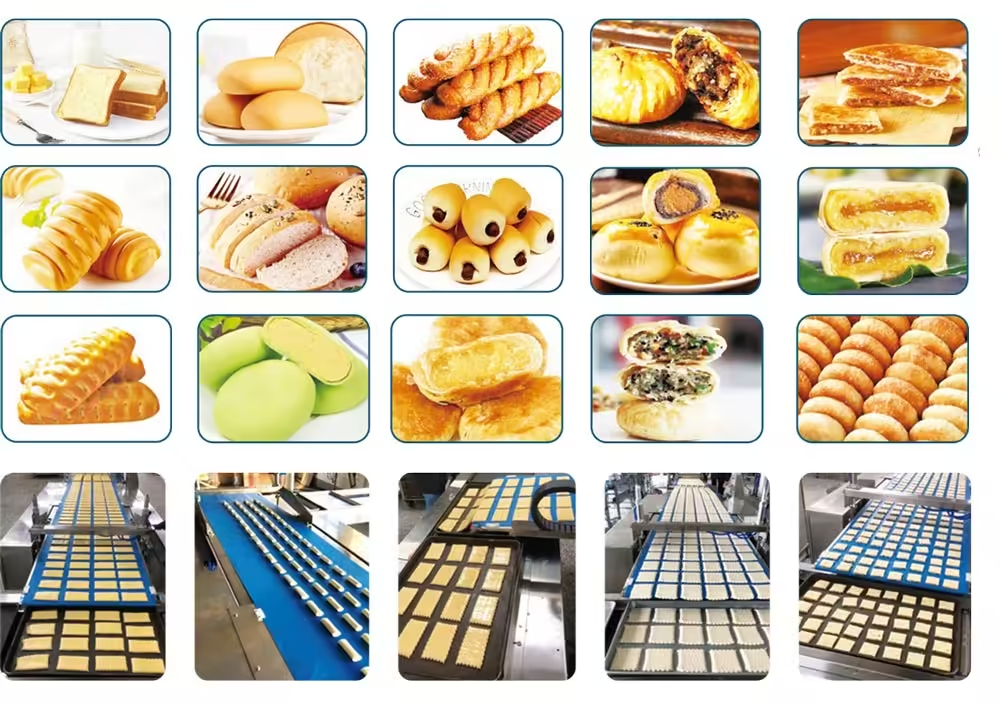


A well-designed bread production line is at the core of a successful bakery operation, enabling consistent output, minimized labor, and enhanced hygiene.

In the rapidly growing baked goods market, businesses need a competitive edge to meet increasing demand without compromising on quality. A well-designed bread production line is at the core of a successful bakery operation, enabling consistent output, minimized labor, and enhanced hygiene. Whether you’re scaling from artisanal methods to industrial production or optimizing an existing setup, the right bread production line is essential for efficiency and sustainability. This blog explores the critical components, innovations, and best practices for implementing a reliable bread production line that aligns with your production goals.
A bread production line is a comprehensive system of interconnected machinery and processes used to mass-produce bread with minimal manual intervention. It typically includes dough mixers, dividers, rounders, proofers, ovens, and cooling conveyors. Each component plays a vital role in maintaining product consistency, improving productivity, and reducing waste.
With the latest technology, bread production lines are no longer one-size-fits-all. Modern systems are modular and scalable, allowing bakeries to expand production capabilities efficiently. Choosing the right configuration ensures better control over output volume and bread quality.
Consistency is crucial for brand reputation. A reliable bread production line maintains precise control over mixing times, fermentation temperatures, and baking conditions. This results in uniform bread size, texture, and taste across every batch.
Automating the baking process reduces dependence on skilled labor while speeding up production cycles. From mixing to packaging, a modern bread production line minimizes manual tasks and downtime, enhancing overall operational efficiency.
Compliance with food safety regulations is non-negotiable. Bread production lines are designed for easy cleaning, with stainless steel constructions, sealed motors, and smart layouts to minimize contamination risks.
Today’s bread production line systems are modular, allowing manufacturers to tailor configurations for different bread types — from sandwich loaves to artisan rolls. Lines can be easily reconfigured or expanded as market demands evolve.
The modular production philosophy has revolutionized bakery equipment. Instead of investing in a one-piece, rigid line, bakeries can build or upgrade systems based on their specific needs. This flexibility supports innovation, reduces initial capital investment, and simplifies future scaling.
Key modular components include:
Choosing a line for bread production depends on multiple factors, including production capacity, product type, available space, and labor resources. Below is a guide to help evaluate the right system for your needs.
| Criteria | Small-Scale Production | Medium-Scale Production | Large-Scale Production |
|---|---|---|---|
| Daily Output Capacity | Up to 1,000 loaves | 1,000–10,000 loaves | 10,000+ loaves |
| Automation Level | Semi-automatic | Fully automatic | Fully automatic with AI/IoT |
| Footprint Requirement | Compact (10–30 sqm) | Medium (30–80 sqm) | Large (80+ sqm) |
| Customization Flexibility | Low | Medium | High |
| Investment Range | Low | Medium | High |
Selecting the right line for bread production from the outset avoids costly retrofits or replacements later on. Engage with an experienced supplier to assess workflow layout, material handling, and sanitation design.
Technological advancements are reshaping how bread is made on an industrial scale. Some of the notable innovations include:
IoT-enabled machines allow remote monitoring and predictive maintenance. Operators can receive real-time data on temperature, humidity, and belt speed to make quick adjustments and prevent downtime.
New-generation tunnel and convection ovens are designed with heat recycling and zoned heating controls, reducing energy usage without sacrificing bake quality.
AI algorithms optimize kneading intensity, fermentation timing, and shaping precision based on live environmental conditions, improving quality consistency and reducing ingredient waste.
Automated cleaning systems for mixers, conveyors, and ovens enhance hygiene while saving water, chemicals, and labor.
Scaling up a line for bread production comes with its set of challenges. These include:
To mitigate these risks, it’s critical to work with a vendor that offers end-to-end support — from design and installation to training and after-sales service.
A mid-sized bakery in Southeast Asia upgraded from a semi-automatic line to a modular line for bread production designed by Chengwo Food Machinery. The results were:
The line was installed with minimal disruption and included a custom packaging module, making it easier to meet export requirements.
A reliable bread production line is more than just machinery — it’s the backbone of your bakery’s success. With the right system, you can boost productivity, meet rising demand, and consistently deliver high-quality products that keep your brand ahead of the curve. Chengwo Food Machinery, with over a decade of experience, offers intelligent, modular, and scalable solutions tailored to your production needs.
Ready to scale your operations? Contact us today to find the perfect line for bread production for your bakery and take your business to the next level.
What types of bread can be produced on a bread production line?
Modern lines can handle a wide range of products including sandwich loaves, buns, rolls, baguettes, ciabatta, and even gluten-free variants.
How long does it take to install a line for bread production?
Depending on complexity and scale, installation typically ranges from 2 to 8 weeks, including testing and training.
Is operator training required?
Yes. Even with high automation, trained operators ensure smoother runs, preventive maintenance, and faster troubleshooting.
Can I scale my line for bread production in the future?
Absolutely. Modular lines allow easy scaling by adding or replacing specific units as your needs grow.
What certifications should a line for bread production meet?
Look for CE, ISO, and local food safety certifications. Machines should also comply with hygiene and material safety standards.
